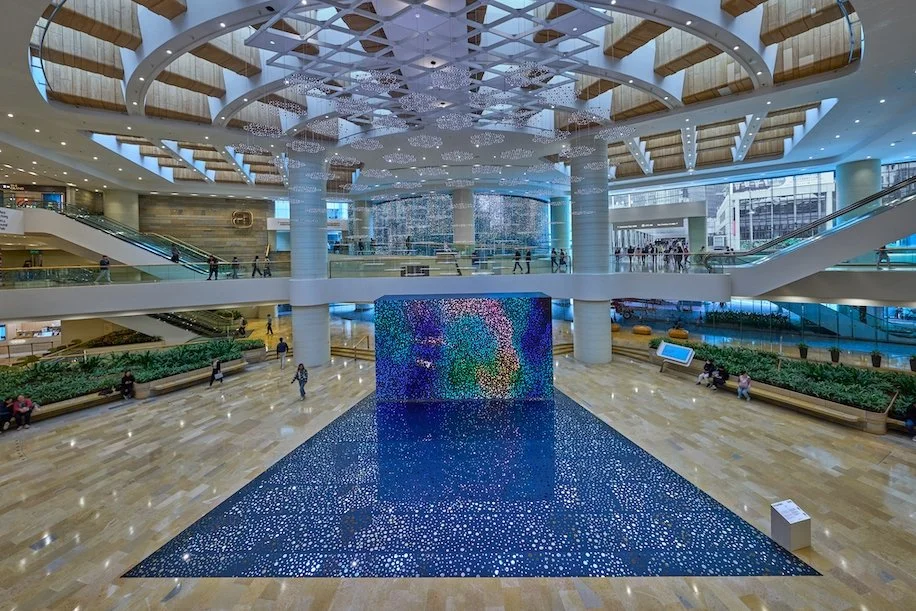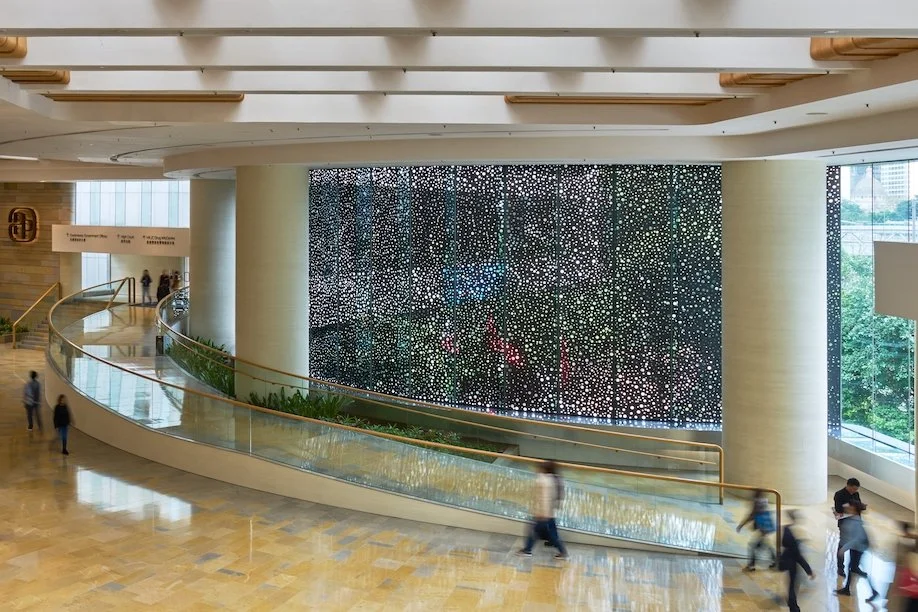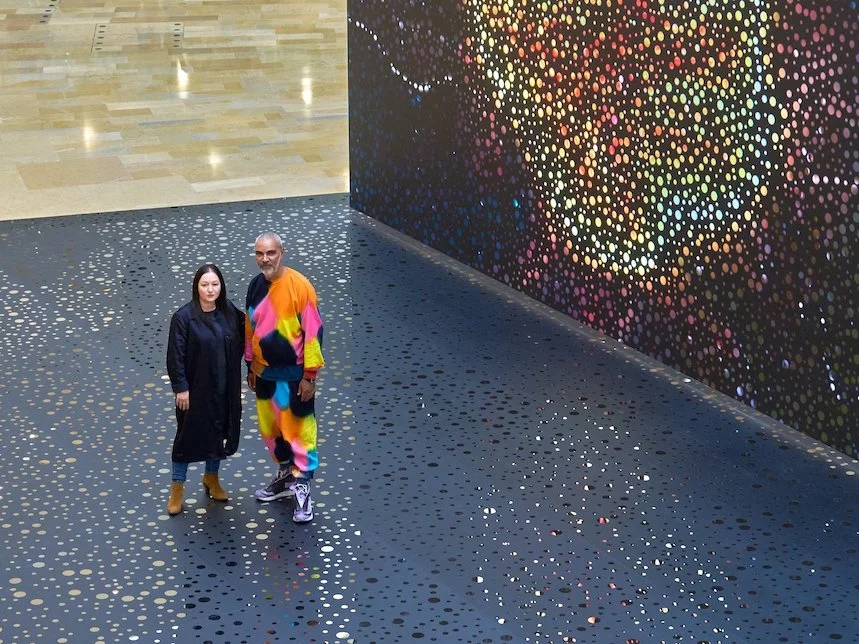Dot to Dot
Artist Daniel Boyd touches down in Hong Kong for Art Basel and brings his singular worldview along for the ride.
Daniel Boyd looks bored. Well, not bored, that’s a strong word. But when Boyd talks about his artwork, in this case an installation piece on display at Pacific Place – yeah, that Pacific Place – until May 7, he kind of looks like he’d rather be doing art than talking about it. His words are measured and deliberate; he doesn’t really toss out quips and sound bites when discussing the racial reckoning that seems to have gripped the post-colonial world. And no, it’s not in your imagination.
“There is a sense of acknowledgement of global histories,” begins Boyd when asked if its seems people, some at least, are more willing to recognise the gross legacies of colonisers. “A lot of it might actually have to do with the pandemic. People being contained, and not being able to move, put us all in the same moment. And I think there was an opportunity for the narrative to not be so controlled,” he says after a few seconds. “And you can’t control the transference of these ideologies anymore. The freedom of information has made that impossible.”
Thoughtful as Boyd is, he’s not dour or stereotypically artsy. He’s cool standing on the dancefloor, as it’s called, despite being on a long-haul flight just hours before. He’s decked out in a bright, multi-coloured sweat suit that clashes gloriously with the morphing colours on the LED screen component of Doan, the piece he’s talking about. Born in Cairns, Boyd counts Kudjala, Ghungalu, Wangerriburra, Wakka Wakka, Gubbi Gubbi, Kuku Yalanji, Yuggera, Bundjalung and ni-Vanuatu heritage, and he’s known for his usurpation and reclamation of Aboriginal dot motifs, colonial historical paintings – and so their meaning – and visuals rooted in the cosmos. All these years later he may still be most recognised for 2006’s We Call Them Pirates Out Here, and 2007’s Sir No Beard, reinterpretations of neoclassical, heroic colonial portraits of Australian godheads like Captain James Cook landing at Botany Bay, and his right hand/botanist Joseph Banks. It’s a kind of art-based critical race theory, the very notion of which has some (wypipo) clutching their pearls for being asked to consider another perspective of history. Finally.
But Doan (which means darkness in Yugambeh, spoken in southeastern Queensland) is more in line with the language and visuals of Boyd’s (now) signature lens works: glue, paint, or metallic material laid on top of a painting, which won him the Bulgari Art Award in 2014. Not at all referencing Aboriginal dot motifs – as he told The Sydney Morning Herald in 2022 – the paintings force the viewer to reflect on their place in the context of the universe, of Australia, of history.
“I’ve always been very aware of the audience, and their role in how they engage. I started with painting, but I didn’t want it to be a static object that sat on the wall,” he says. When you stand in front of one of his paintings, “There’s all these lenses on the surface, with dark spaces in between. They’re convex, so the way the light works with it the audience activates the surface of the work. So they become the author and connect to it in whatever way they wish.”
Dots, in many forms, have long been a medium through which to interrogate connectedness. A single dot takes on new meaning when tossed into a large mass of them, essentially creating a bigger picture, figuratively and literally. The pointillists proved that back in the 1880s, and Boyd expanded on it when he started experimenting with installation-sized pieces at Dhaka Art Summit, at Gropius Bau in Berlin (below), and now in Pacific Place. Doan is a three-part work: the mirrored floor, the moving LED screen, and a window treatment on the mezzanine level facing Queensway. The window segment in particular could be Boyd at his most metaphysical and contemplative of, “Light and dark. The universe and the abyss.” It works as a counterpoint to a sense of control Boyd is quite adamant we all need to drop. Curator Alexie Glass-Kantor off-handedly commented on her favourite time of day to see the window (the golden hour of dusk, assuming there’s sun in Admiralty). Boyd’s response later is a matter-of-fact, “We need to let go sometimes. We try and control things too much. You can’t control light. The unconscious and the dream state are part of that, and that’s what I’m interested in.
“We all share these histories and forms of governance and oppression, but the work behind me is about the unknown; the spirit we can’t contain,” he says. “The language might trigger someone to think about the stereotype of what an Aboriginal or First Nations persons from Australia is, but hopefully they’ll grow with this exchange, and move forward understanding [the art] isn’t tied to a particular culture or tradition. This relates to psychoanalysis, science, cultural production, the self and giving yourself over to not understanding something. Hopefully people will think about who I am and my experience, without me proscribing a narrative.” He shrugs ever so subtly. “That’s like answering a question with multiple questions.”
None of Boyd’s work is entirely free of political comment, but as of this moment, he’s one of Australia’s best known contemporary artists and very much part of the so-called “establishment”. “Big Art”, you might say, or the “Art Industrial Complex”. Installations at the likes of Art Summit or Gropius Bau seem – for lack of a better word – correct for an artist of Boyd’s stature (yeah, he’d probably shit all over that idea). Shopping malls, however, are a bridge too far. Or are they?
“I don't care,” is Boyd’s immediate response to the idea that art, his art, in a mall. Art and malls are like oil and water: they should never mix. To the beret set, malls are a symptom of selling out. “I think the people that move through these spaces might not go to an art fair, or they might not go to a museum. This exchange is exciting for me,” he says, pooh-poohing lingering elitist notions of where art belongs – and who’s allowed to look at it. “These experiences need to be offered to people who don’t belong to a certain set, or who don’t normally engage with art. I try to be as accessible as possible to whatever audience is going to bring something to the work. They come to the stage and they have an exchange where they’re authoring the experience.” That goes directly to Doan immersing its viewers, or participants, in the concept of the shared existence. “As a human being you relate to a particular place in the world; where your cultural traditions are from. So it’s about sharing these, helping people understand the beauty in difference. Having an exchange without losing a sense of oneself is important. We can’t lose these cultures and traditions. What’s beautiful about the world is that we are all different. Each individual has a unique experience, and we need to celebrate that.”
Boyd admits the politics surrounding his work might connect to interrogating and reclaiming identity and who he is as a person, but also that those ideas mean different things to different people. The key to reconciling – is it reconciling? – colonial histories varies; what’s crucial is, “Making these opportunities poetic in the way that they offer a ferocity to the exchange – so the ideas aren’t contained in this linear way. There’s freedom in poetics.” Doan’s essentially a blank slate that offers us all a chance, equally, to consider identity, especially at a time when homogeneity is being rewarded and push-back on the dominance of conventional history is routinely met with paranoid vitriol. Boyd hesitates to label himself as an Aboriginal artist. “I’m an artist. And I come from a particular place in the world; I belong to these traditions. It’s the same as anyone else in the world and I don’t like to be contained within a stereotype of what an Aboriginal person is.” It’s one thing to describe someone, it’s quite another to define them.
“Yeah. The definitive is the problem. That’s the role the arts play in the poetic exchange. It connects to our aura, and that can’t be framed.” — DEK
Doan
Where: Park Court L1, Pacific Place, 88 Queensway, Admiralty
Hours: Through April 7, 2024, 10am – 10pm
Closed: N/A
Details: Information at Art Basel: Encounters






